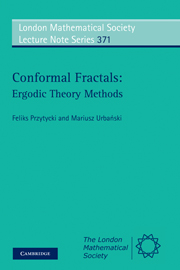Book contents
- Frontmatter
- Contents
- Introduction
- 1 Basic examples and definitions
- 2 Measure-preserving endomorphisms
- 3 Ergodic theory on compact metric spaces
- 4 Distance-expanding maps
- 5 Thermodynamical formalism
- 6 Expanding repellers in manifolds and in the Riemann sphere: preliminaries
- 7 Cantor rep ellers in the line; Sullivan's scaling function; application in Feigenbaum universality
- 8 Fractal dimensions
- 9 Conformal expanding repellers
- 10 Sullivan's classification of conformal expanding repellers
- 11 Holomorphic maps with invariant probability measures of positive Lyapunov exponent
- 12 Conformal measures
- References
- Index
9 - Conformal expanding repellers
Published online by Cambridge University Press: 05 April 2013
- Frontmatter
- Contents
- Introduction
- 1 Basic examples and definitions
- 2 Measure-preserving endomorphisms
- 3 Ergodic theory on compact metric spaces
- 4 Distance-expanding maps
- 5 Thermodynamical formalism
- 6 Expanding repellers in manifolds and in the Riemann sphere: preliminaries
- 7 Cantor rep ellers in the line; Sullivan's scaling function; application in Feigenbaum universality
- 8 Fractal dimensions
- 9 Conformal expanding repellers
- 10 Sullivan's classification of conformal expanding repellers
- 11 Holomorphic maps with invariant probability measures of positive Lyapunov exponent
- 12 Conformal measures
- References
- Index
Summary
Conformal expanding repellers (abbreviation CERs) have already been defined in Chapter 6, and some basic properties of expanding sets and repellers in dimension one were discussed in Section 6.2. A more advanced geometric theory in the real one-dimensional case was covered in Chapter 7.
Now we have a new tool: the Frostman Lemma and related facts from Chapter 8. Equipped with the theory of Gibbs measures, and with the pressure function, we are able to develop a geometric theory of CERs, with Hausdorff measures and dimension playing the crucial role. We shall present this theory for C1+ε conformal expanding repellers in ℝd. The main case of our interest will be d = 2. Recall (Section 6.2) that the assumed conformality forces for d = 2 that f is holomorphic or anti-holomorphic, and for d ≥ 3 that f is locally a Möbius map. Conformality for d = 1 is meaningless, so we assume C1+ε in order to be able to rely on the Bounded Distortion for Iteration lemma.
We shall outline a theory of Gibbs measures from the point of view of multifractal spectra of dimensions (Section 9.2) and pointwise fluctuations due to the Law of Iterated Logarithm (Section 9.3).
For d = 2 we shall apply this theory to study the boundary Fr Ω of a simply connected domain Ω, and in particular a simply connected immediate basin of attraction to a sink for a rational mapping of the Riemann sphere.
- Type
- Chapter
- Information
- Conformal FractalsErgodic Theory Methods, pp. 236 - 283Publisher: Cambridge University PressPrint publication year: 2010

